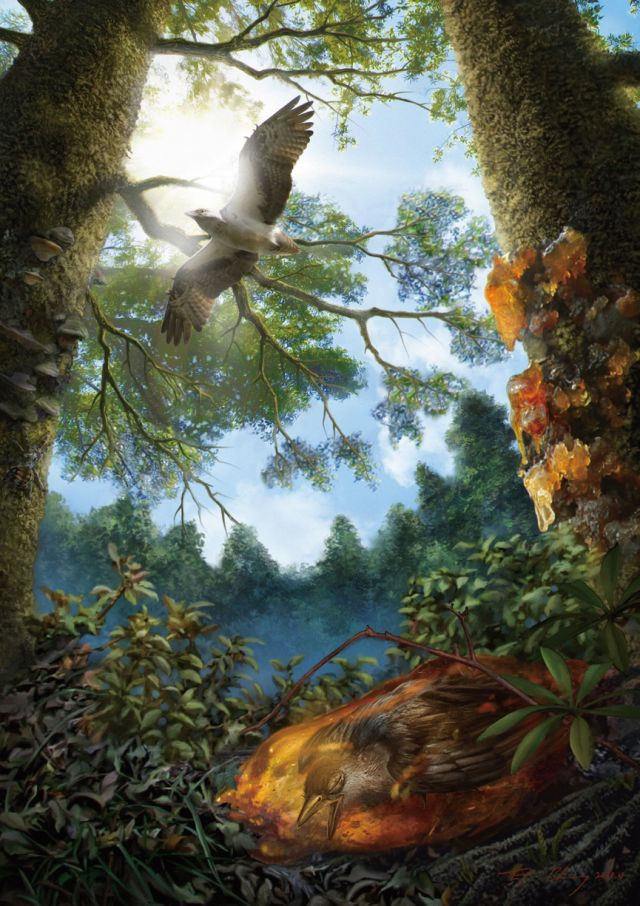The most intact bird fossil in amber 99 million years
The 99 million-year-old young bird carcass is the most complete bird fossil found from amber mines in Myanmar that scientists once knew.
The body pressed by the small bird that lived 99 million years ago was discovered wrapped in a chiseled amber slab in Myanmar, National Geographic reported on February 2. Although many birds found in Myanmar amber were previously more noticeable in appearance, there is no specimen that contains as much bone as this immature bird. Its fossils include the back of the skull, the majority of the spine, buttocks, the wings and thigh parts.
The newly discovered bird is also special because researchers can better see the internal structure of the young prehistoric creature, according to co-author Ryan McKellar at the Saskatchewan Royal Museum in Regina, Canada.
The amber mass holds the bird carcass.(Video: Sina).
"The opaque amber, which contains many small woods. It seems to be created above or near the forest floor, " McKellar said. This means the appearance of the bird is not unique but the inside of the bird is much more interesting. "When preparing for a study in Myanmar, they polished the front half of the specimen, allowing us to observe the chest cavity and skull , " McKellar said.
The findings add to the special collection of Cretaceous fossils from amber mines north of Hukawng valley in Myanmar. Over the past few years, the area has provided some beautiful bird fossils, a feathered tail of a small carnivorous dinosaur and the skeleton of a newly hatched bird. Last December, researchers even found corpses of ticks sucking on dinosaur blood in amber.
Lida Xing, the lead author of the detailed specimen study in Science Bulletin, shared the first time seeing a bird sold as jewelry in Myanmar in 2015, his heart beating very fast. The team was fortunate to be able to acquire the bird for the Dexu Institute of Paleontology in Chaozhou, China. The amber-covered birds can sometimes be sold for $ 500,000, beyond the ability of scientists, according to Xing, a paleontologist at the China Geological Sciences University in Beijing.

Restoring the bird stuck in the later sap into amber.(Photo: National Geographic).
Based on the results of the analysis, the team concluded that the young bird stuck to the sap line when alive or dead. Moisture makes the sap to foam slightly, then creates a chisel of amber. Some bones and soft tissue are lost and sediment builds up in the gaps.
The bird is about 6 cm long. The hair and bone structure shows that it is an enantiornithine , an extinct primitive bird with an unknown flight 66 million years ago. "Although they have just hatched, they have enough feathers on their wings and tails. They have weak spinal columns, so they may not be good flying species ," McKellar speculated.
When alive, the bird has beaks and a chestnut-brown body or walnut color, with the hairs of the head and neck. Unfortunately, the fossil lacks two characteristics that help identify the species: a beak filled with teeth and claws on the wings. Researchers believe that young birds can be attacked by predators and fall from the nest to plastic seeping from the same trunk. Some pieces of plants and cockroaches caught in the amber block may originate from the nest.
- Discover intact marine life in amber 99 million years
- The discovery of gecko fossils lies in amber dating from nearly 100 million years
- Detecting fossil fossils strange 99 million years in amber
- Amazingly discovered about the 100 million-year-old bird in amber
- Fossil dragonflies lose their head 100 million years
- Fossilized pig mold in amber 30 million years
- Found a 99 million-year-old fossil bird covered in amber
- Discovering fossil ants 52 million years ago in India
- China found 7 million years old bird fossils
- Discovered the ancient bird lung intact after 120 million years
- Video: 49 million year old spider fossil
- The marine fossil remains intact after 525 million years
 Discovered an ancient centipede fossil 99 million years old
Discovered an ancient centipede fossil 99 million years old Discovered bat-like dinosaurs in China
Discovered bat-like dinosaurs in China Discovered a 200-year-old bronze cannon of the coast
Discovered a 200-year-old bronze cannon of the coast Discover 305 million-year-old spider fossils
Discover 305 million-year-old spider fossils